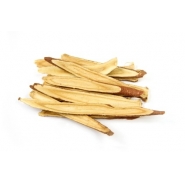1. What is Liquorice root ?
Liquorice root (Glycyrrhiza glabra L.) also known as licorice and sweetwood, is native to the Mediterranean and certain areas of Asia. Historically, the dried rhizome and root of this plant were employed medicinally by the Egyptian, Chinese, Greek, Indian, and Roman civilizations as an expectorant and carminative.
In fact, the name liquorice or licorice is derived from the Ancient Greek glukurrhiza, meaning 'sweet root.
2. What are the clinical implication of Liquorice root ?
The extract shows a cramp-relieving action and accelerates the healing of stomach ulcers.
In modern medicine, Licorice extracts have been used for more than 60 years to treat chronic hepatitis, and also have therapeutic benefit against other viruses, including human immunodeficiency virus (HIV), cytomegalovirus (CMV), and Herpes simplex.
It is also used as an expectorant for coughs and bronchial catarrh.
Topical licorice preparations have been used to sooth and heal skin eruptions, such as psoriasis and herpetic lesions.






























